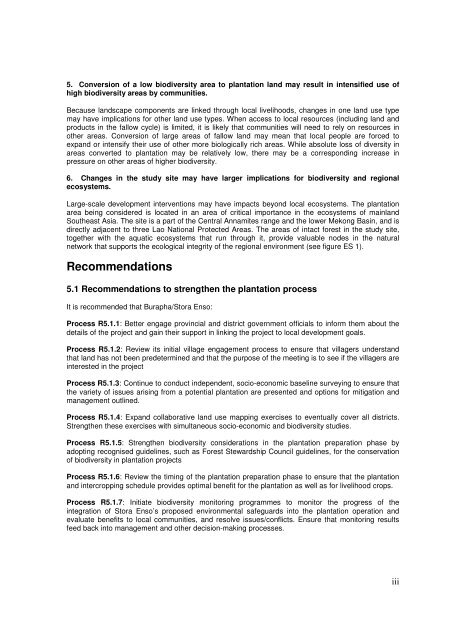Part 1 – A Rapid Participatory Biodiversity Assessment - IUCN
Part 1 – A Rapid Participatory Biodiversity Assessment - IUCN
Part 1 – A Rapid Participatory Biodiversity Assessment - IUCN
Create successful ePaper yourself
Turn your PDF publications into a flip-book with our unique Google optimized e-Paper software.
5. Conversion of a low biodiversity area to plantation land may result in intensified use of<br />
high biodiversity areas by communities.<br />
Because landscape components are linked through local livelihoods, changes in one land use type<br />
may have implications for other land use types. When access to local resources (including land and<br />
products in the fallow cycle) is limited, it is likely that communities will need to rely on resources in<br />
other areas. Conversion of large areas of fallow land may mean that local people are forced to<br />
expand or intensify their use of other more biologically rich areas. While absolute loss of diversity in<br />
areas converted to plantation may be relatively low, there may be a corresponding increase in<br />
pressure on other areas of higher biodiversity.<br />
6. Changes in the study site may have larger implications for biodiversity and regional<br />
ecosystems.<br />
Large-scale development interventions may have impacts beyond local ecosystems. The plantation<br />
area being considered is located in an area of critical importance in the ecosystems of mainland<br />
Southeast Asia. The site is a part of the Central Annamites range and the lower Mekong Basin, and is<br />
directly adjacent to three Lao National Protected Areas. The areas of intact forest in the study site,<br />
together with the aquatic ecosystems that run through it, provide valuable nodes in the natural<br />
network that supports the ecological integrity of the regional environment (see figure ES 1).<br />
Recommendations<br />
5.1 Recommendations to strengthen the plantation process<br />
It is recommended that Burapha/Stora Enso:<br />
Process R5.1.1: Better engage provincial and district government officials to inform them about the<br />
details of the project and gain their support in linking the project to local development goals.<br />
Process R5.1.2: Review its initial village engagement process to ensure that villagers understand<br />
that land has not been predetermined and that the purpose of the meeting is to see if the villagers are<br />
interested in the project<br />
Process R5.1.3: Continue to conduct independent, socio-economic baseline surveying to ensure that<br />
the variety of issues arising from a potential plantation are presented and options for mitigation and<br />
management outlined.<br />
Process R5.1.4: Expand collaborative land use mapping exercises to eventually cover all districts.<br />
Strengthen these exercises with simultaneous socio-economic and biodiversity studies.<br />
Process R5.1.5: Strengthen biodiversity considerations in the plantation preparation phase by<br />
adopting recognised guidelines, such as Forest Stewardship Council guidelines, for the conservation<br />
of biodiversity in plantation projects<br />
Process R5.1.6: Review the timing of the plantation preparation phase to ensure that the plantation<br />
and intercropping schedule provides optimal benefit for the plantation as well as for livelihood crops.<br />
Process R5.1.7: Initiate biodiversity monitoring programmes to monitor the progress of the<br />
integration of Stora Enso’s proposed environmental safeguards into the plantation operation and<br />
evaluate benefits to local communities, and resolve issues/conflicts. Ensure that monitoring results<br />
feed back into management and other decision-making processes.<br />
iii

















